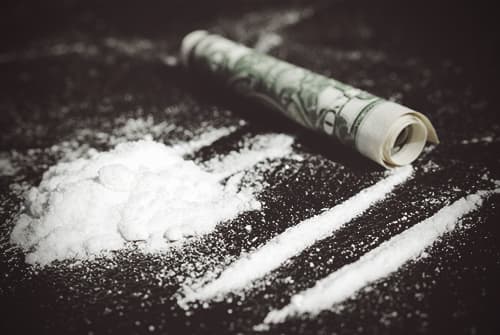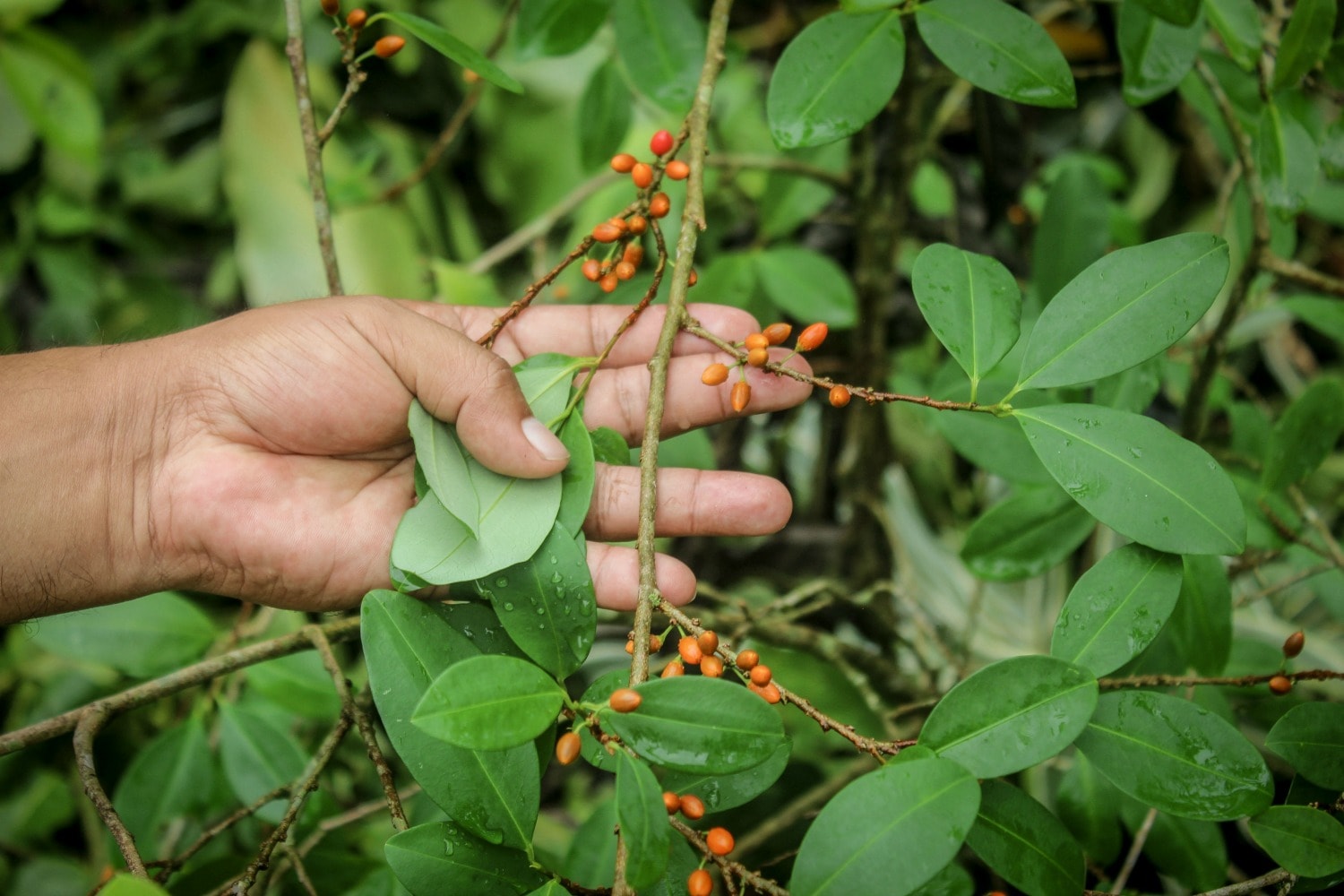Cocaine has a long history going back thousands of years. Indigenous peoples in South America regularly chewed the leaves of the native coca plant. They believed that the practice of chewing coca leaves, which contain nutrients as well as the psychoactive components of cocaine, increased their strength and energy. Archeological artifacts from these ancient cultures indicates a high prevalence of cocaine use, with people frequently depicted with mouths full of coca leaves. Some evidence indicates that these indigenous civilizations even used cocaine for medical purposes, to treat common ailments as well as a local anesthetic during basic surgeries. When the Americas were invaded and incorporated into the Spanish empire, Europeans were at first skeptical of the practice of chewing coca leaves, but once they understood the psychoactive effects they began taxing the crop. Not only has the drug been used for thousands of years, the coca plant has a long history of being a means for profitable business ventures.
Attempts to isolate the psychoactive alkaloid cocaine from the coca plant were unsuccessful for many years. In 1855, however, knowledge of chemistry had advanced sufficiently to make the isolation of cocaine possible. Cocaine’s medical use rapidly expanded throughout Europe. It was used primarily as a local anesthetic, but cocaine was also used to treat a variety of other ailments due to its stimulating and hunger-suppressing effects. Medical uses that were touted at the time include treating eye disorders, whitening of the teeth, and dealing with flatulence. Cocaine was also widely believed not to be addictive.
As cocaine’s popularity soared, it also became a common recreational product. Stores regularly sold a wine containing cocaine called Vin Mariani. The original recipe for Coca Cola also contained coca leaves and had mild psychoactive effects. Even some brands of cigarettes contained traces of the coca plant. During the Victorian era, cocaine was an important cultural touchstone, with fictional characters like Sherlock Holmes famously abusing cocaine as well as real individuals like Sigmund Freud touting the benefits of the substance. By the turn of the 20th century, however, the risks of cocaine abuse began to be taken seriously by the medical community and governments took steps to regulate it.

Today cocaine is a widely used recreational drug. The use of cocaine in powdered form is associated with the rich, glamorous, and successful. In the 1980s, however, the invention of crack cocaine saw a new rise in use. Crack cocaine, a smokable form of cocaine that many experts consider the most addictive form of cocaine, ravaged poor inner city communities in particular. While cocaine in its powdered form remains popular and has glamorous connotations, crack cocaine came to be associated with poverty and destitution. As a result, the police and the United States government cracked down on the substance more stringently. Historians cite the crack cocaine epidemic of the 1980s and 90s as a principle motivating factor for the War on Drugs, a war that continued to be waged today.
Cocaine is a powerful and highly addictive drug that comes in many forms. While it does have limited medical use as an anesthetic, it is more widely used for recreational purposes. Cocaine can be snorted, smoked, or injected into the vein. Users who take cocaine experience a surge in energy and an uplifted mood. While the positive effects are increased confidence, energy, and euphoria, many people also experience negative symptoms such as agitation and psychosis. The “high” from cocaine has a very rapid onset, with most people obtaining desired effects within seconds of using the drug. These effects are very short-lived, however, and users must repeatedly dose themselves to avoid withdrawal. As a result, cocaine is one of the most addictive recreational drugs.
Cocaine, which is derived from the leaves of the common South American coca plant, has a long history of use for religious, ceremonial, medical, and recreational purposes. Today it is the second most widely consumed illegal drug in the world, behind only cannabis. In the United States, approximately 5 million people regularly use cocaine, amounting to 2% of the country’s population. Despite efforts to curb cocaine distribution and treat addiction, cocaine’s popularity has remained steady over the last two decades.
Unfortunately, this stimulant drug is both addictive and extremely dangerous. In 2017, cocaine was a major factor in approximately 1 in every 5 fatal drug overdoses in the United States. Cocaine raises users’ heart rates and increases blood pressure. Even after a short period of use, users are likely to develop physical dependence, causing them to crave and seek out the drug. Regular cocaine use increases the risk of stroke, heart attack, blood infections, and lung issues. Cocaine overdoses are often fatal, with 14,000 Americans dying of cocaine overdose in 2017 alone. The risk of a life-threatening overdose occuring increase dramatically when cocaine is used in conjunction with other drugs. The opioid epidemic that is currently raging across the United States has resulted in an increase in the number of people using cocaine alongside opioids. When cocaine and opioids are used together, a practice known as “speedballing,” the risks compound, since cocaine is a stimulant and taxes the heart, and opioids are depressants that slow down breathing. People mixing the two substances increase their risk of suffering from respiratory depression, which is often fatal.
Cocaine is made from the leaves of the coca plant, native to South America. Cocaine production begins with harvesting the coca plant. Harvesters remove the leaves and set them out to dry in the sun. After the leaves have dried somewhat, the next step is mincing them. People often add small amounts of ammonia, lime, and cement powder as they agitate the minced leaves. After the leaves have been agitated and minced, workers add gasoline to the mix. The leaves are left out to soak in the gasoline for several hours. After a period of waiting, workers drain the gasoline and remove excess leaves. They add ammonia to separate the cocaine from the diesel gasoline, wait for it to dry, and then dissolve the substance in solvent. Lastly, producers remove the solvent and allow the final paste-like substance to dry into solid bricks of cocaine.

When distributors sell cocaine on the streets, however, they rarely sell cocaine in its form form. They dilute the cocaine with a number of substances so that they can sell large quantities of the powder for higher profits. In fact, the United Nations Office on Drugs and Crime estimates that most “cocaine” sold on the streets contains less than 40% cocaine. Additives include innocuous substances like baking soda, but often sellers add more dangerous drugs, such as fentanyl. The uses of contaminated cocaine can lead to overdoses when other drugs are added. Most users do not have the resources or know how to test cocaine’s purity. Unless an individual possesses a cocaine purity test kit, the unpredictability of cocaine purity can also lead to overdoses when users who are accustomed to lower purities partake in cocaine with higher purity.
The process of making crack cocaine involves some additional steps. However, this recipe is widely available and easy to do at home, which is part of what makes crack cocaine use so prevalent. Producers begin by dissolving powder cocaine in hot water. They then add baking soda and boil the solution to separate out the solids. The mixture is then left out to cool, and producers finish the process by cutting up the solid components into “rocks.” These rocks of concentrated “crack” cocaine can then be smoked or sold on the streets.
Due to its long history and popularity, people use a wide variety of slang terms to refer to cocaine and its derivative, crack cocaine. Many of these terms were created in an effort to evade detection by authorities, such as the Drug Enforcement Agency (DEA). Some are used colloquially in party environments to refer to the substances.
Common terms for cocaine include:
Crack cocaine has its own set of street names, among them:
While cocaine can be consumed in multiple forms, including cocaine hydrochloride, freebase cocaine, and crack cocaine, the effects remain relatively similar. Different types of cocaine and different methods of administering it, such as smoking, snorting, or injecting, differ mainly in terms of the intensity and speed of effects. While purer forms of cocaine increase the risk of overdose, even powder cocaine that has been cut with another substance can lead to overdose from a single use, especially if it has been cut with another drug, such as fentanyl.
The effects of cocaine include:

Of the countless illegal drugs available on the market, cocaine is today the second most popular in the United States behind cannabis. While approximately 5 million Americans use cocaine regularly (2% of the population), 1.5 million used cocaine in the last month. Young people in particular are drawn to this drug. While cocaine use has fallen somewhat among highschool-aged adolescents. According to a study conducted by Monitoring the Future, 4.7% of 8th graders in 1999 had tried cocaine in their lifetimes. The prevalence of cocaine use among 8th graders has since fallen to approximately half a percent. Young adults, however, remain considerably at risk from the dangerous effects of cocaine and cocaine addiction. In the past month, 1.4% of adults between the ages of 18 and 25 reported using cocaine in the last month. This number is likely significantly higher, given that the report was based only on users who were willing to admit their usage.

While public health concerns about cocaine use have been obscured somewhat by the more infamous opioid crisis, between 2010 and 2020 cocaine overdoses actually increased. Between 2015 and 2016, cocaine overdoses actually increased at a rate of 52.4%. Between 2016 and 2017, the rate of cocaine overdose increased by 34.4%, with 13,942 overdose deaths being attributed to cocaine in 2017 alone. Much of these cocaine-related deaths are in fact being driven by the opioid crisis. Users who mix the two substances are at a much higher risk due to their opposing effects: opioids slow down the body’s respiratory system while cocaine, a stimulant, taxes the heart. As the opioid epidemic rages on, cocaine users, who make up an enormous portion of the overall population, will continue to overdose at alarmingly high rates.
Users are driven to take cocaine initially for a number of reasons, but they primarily take it because it makes them feel good. The main reason behind the feeling of euphoria that cocaine provides is that it releases large amounts of dopamine in the brain. Dopamine is a chemical that plays a large role in the brain’s reward circuit, affecting both motivation and decision-making. While many pleasurable activities, such as exercise, having sex, or laughing, can release dopamine, cocaine does so at a much higher quantity.
Cocaine also has a very rapid onset, and neurological research has shown that the less time there is between an activity and a dopamine release, the more likely the brain is to associate those two events – meaning that drugs with rapid onsets are far more addictive. Cocaine’s effects are also quite temporary. Within 30 minutes of consuming cocaine, users begin to experience the initial effects of withdrawal, which include fatigue, depression, slowed thinking, and problems with appetite and sleep. To avoid these symptoms, many users take cocaine multiple times in one session. Physical dependence can occur very shortly after cocaine use, and this physical dependence can become more and more insurmountable each time the drug is taken.
Over time, users with physical dependence may try to quit using cocaine — often to little success. Individuals who find it difficult or impossible to manage their cocaine usage have likely developed a substance use disorder, or addiction. People who are addicted to cocaine are often at war with themselves, wanting to quit but nonetheless prioritizing cocaine use and cocaine-seeking behavior above all else. Relationships with friends and family are likely to suffer. Many have problems at work or school. Financial and legal difficulties can arise when an individual is caught in possession of cocaine. Above all, cocaine addicts increase their likelihood of developing a variety of life-threatening problems with both their physical and mental health. After only a short period of time, people who have developed a cocaine addiction may find their lives unrecognizably different.

Due to stigma surrounding addiction and a widely held belief that substance abuse arises from a personal failure to exert sufficient willpower, many people suffering from cocaine addiction avoid seeking help. Treating addiction involves changing ingrained thought and behavior patterns; users who hope to stay sober merely by undergoing a short cocaine cleanse will rarely have success. Concerned friends and family members can often help an individual with substance use disorder begin to recognize their problem. Fortunately, for individuals who are motivated to reach out, a wide variety of treatment options are available, from inpatient treatment programs that offer 24 hour care, to outpatient programs with more flexible requirements. Addiction cannot be cured but daily treatment can offer a reprieve from the symptoms, and many people continue to stay involved in support groups and 12-step programs like Cocaine Anonymous even after finishing formal treatment. Effective cocaine rehab programs offer not only relief from the immediate symptoms of cocaine addiction, but a chance to rebuild ones life. Most find that long-term sobriety continues to offer greater rewards with each passing year.